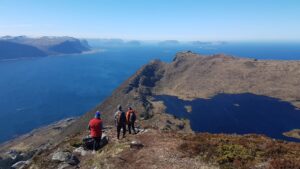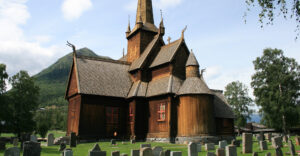2050 Jessheim
22 days roundtrip from Oslo to Stavanger to Geiranger to Oslo – Norwegian campervan tour
Posted: February 16, 2025
Estimated Reading time: 18 minutes
Explore Norway’s beauty, culture, and history on a 22-day campervan adventure, discovering sights, hidden gems, and outdoor experiences.
Day 1-2: Oslo – Start of the Journey
Oslo, the vibrant capital of Norway, is a city where urban sophistication converges with outdoor adventures, set against a backdrop of stunning natural beauty and historical landmarks. Whether you are interested in exploring world-class museums, enjoying the picturesquefjord, or indulging in the city’s dynamic scene, Oslo offers a rich experiences.
Pick-up: Collect your campervan from Touring Campers at Oslo Gardermoen Airport.
Stay: Bogstad Camp & Turistsenter As a customer of Touring Campers, you get access to an exclusive discount code of 15%, which can be used on one booking in Campio.
Explore: Walk around the Oslo Opera House and The Harbour Promenade, stroll through the Vigeland Sculpture Park, and take a walk at Aker Brygge & Tjuvholmen
Eat: Enjoy dinner at VulkanFisk Seafood Bar in Mathallen food hall.
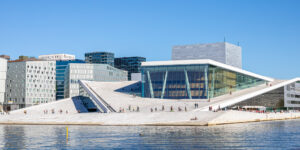
https://www.visitoslo.com/en/product/?tlp=2988133&name=The-Norwegian-National-Opera–Ballet
Attractions and Museums:
Kon-Tiki Museum: This exhibit celebrates the adventurous spirit of Thor Heyerdahl, showcasing his balsa wood raft journey Peru to Polynesia.
Norwegian Maritime Museum: A family-oriented venue that explores Norway’s maritime history, including its Viking heritage.
Holmenkollen Ski Jump and Museum: Provides insights into 4,000 years of skiing history, including polar exploration by Fridtjof Nansen, with stunning of Oslo from the ski jump’s observation deck
Vigeland Sculpture Park: This iconic park, located within Frogner Park, over 650 sculptures by Gustav Vigeland in bronze, granite, and wrought iron making it a must-visit destination for art enthusiasts.
The Fram Museum: Dedicated to polar exploration, this museum houses the Fram and Gjøa, highlighting Norway’s significant contributions to Arctic expeditions.
Experiences:
Oslofjord: It connects Oslo to the North Sea, providing numerous cruise options or opportunities for more intimate explorations by kayak or canoe. It offers a fantastic way to view the city’s landmarks from different perspective.
Culinary Scene: Oslo’s dining scene is both diverse and innovative, Norway’s culinary heritage alongside contemporary trends. From Michelinred establishments to charming cafes and bustling food markets there is something to please every palate.
Planning Your Visit:
Oslo caters to a broad spectrum of interests and activities throughout the year. Whether one is drawn to the cultural richness of the city’s museums and galleries, tranquility and beauty of the Oslofjord, or the excitement of outdoor adventures in nearby nature, Oslo promises an unforgettable experience. The city’s compact size and efficient public transportation system make it easy to explore all has to offer. For more detailed information on planning your trip to Oslo, including attractions, accommodations, and activities, you may visit official tourism websites such as Visit Norway – Oslo and Visit Oslo
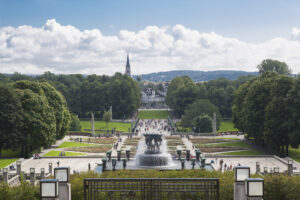
https://www.visitoslo.com/no/produkt/?tlp=2983043&name=Vigelandsparken
Day 3-4: Oslo to Rjukan – Industrial Heritage and Hiking
Rjukan, situated in the Telemark region Norway, is a center of historical significance and outdoor activities surrounded by majestic landscapes for which Norway is renowned. With attractions such asustatoppen and the Norwegian Industrial Workers Museum atemork, it offers a blend of natural beauty and intriguing history.
Drive: Oslo to Rjukan (approx. 3 hours).
Explore: Visit the Norwegian Industrial Workers Museum, hike up to the Gaustatoppen, (Visit Telemark offical site for Gaustatoppen) for panoramic views.
Eat: Eat at one of the local resturants, TripAdvisor – Resturants in Rjukan
Stay: Rjukan Camping or Rjukan Bobilparkering
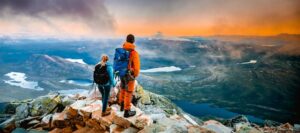
https://gaustabanen.no/eventer/sommer22/
Experiences:
Gaustatoppen: This towering offers breathtaking views across Norway. Easily accessible, it a favorite among hikers, promising southern’s longest view on clear days. From to September the trail from Stavsro to Gaustatoppen provides a family-friendly hike, leading to the Gaustatoppen Tourist Cabin the summit.
Krossobanen: Europe’s oldest tramway provides a convenient route to the breathtaking hiking and biking trails on the Hardangervidda mountain plateau offering magnificent views of the valley below.
Historical Sites:
Norwegian Industrial Workers Museum at Vemork: This museum, situated in the Vemork hydroelectric plant, delves into the region’s industrial worker history and the heroic deeds of WWII’s Heavy Water Sabotage. It is a must-visit for history enthusiasts, featuring exhibitions that chronicle a significant era of Norwegian and world history.
Rjukan Railway: Though no longer operational, this railway’s history is tied to the industrial growth of the area and the famous WWII sabotage efforts. It’s a glimpse into the strategic importance of Rjukan during the war.
Unique Attractions:
The Sun Mirror: Installed on the mountainside, this innovative project directs sunlight into Rjukan’s town square during the winter months, when the valley is normally shadowed from the sun.
Planning Your Visit
Rjukan offers a diverse array of activities throughout the year, to both summer hikers and winter skiers. The town provides various accommodations, ranging from hotels to more rustic lodging options, ensuring a comfortable stay regardless of your adventure. With unique industrial and war history combined with the magnificent natural backdrop of Gaustatoppen and accessibility Hardangervidda,jukan is a compelling destination for anyone to explore Norway’s rich cultural natural heritage.
For those planning a trip, it is advisable to explore the offerings of each season, as Rjukan presents a different face in’s warmth and winter’s snow. Whether you are drawn to the historical depths of the Norwegian Industrial Museum, the panoramic heights of Gaustatoppen, or the serene beauty of the landscapes,j awaits with experiences to fill your journey with wonderFor more information on planning your trip to Rjukan, including attractions, accommodations, and activities, you can visit official tourism websites such as Visit Norway – Rjukan.
Day 5-6: Rjukan to Stavanger – Gateway to the Fjords
Stavanger, a city renowned for its exceptional combination of stunning natural beauty, vibrant cultural scene, and importance, provides a variety of experiences for visitors. Whether you are an outdoor enthusiast, a history aficionado, or a culinary connoisseur, Stavanger has something unique to offer you.
Drive: Rjukan to Stavanger (approx. 6 hours).
Explore: Old Stavanger , visit the Norwegian Petroleum Museum , take a Ferry trip to Lysefjorden with FjordTours
Eat: Fish & Cow for a modern dining experience.
Stay: Mosvangen Camping
Outdoor Adventures:
Stavanger serves as the perfect base for exploring some of Norway’s most stunning natural landscapes, including the Lysefjord, Pulpit Rock (Preikestolen), and Kjerag. These destinations provide thrilling hiking experiences with spectacular views over the fjords and mountains. For a unique geological exploration, the Magma UNESCO Global Geopark offers a look into the earth’s ancient past with its lunar landscapes.
Historical and Cultural Insights:
The region is steeped in history, prominently featured at the Norwegian Industrial Workers Museum at Vemork, where visitors can explore the heavy water sabotage story from World War II. Gamle Stavanger (Old Stavanger) presents Europe’s oldest wooden house settlement, providing a scenic walk through history. The Stavanger Maritime Museum and Breidablikk Museum further emphasize the maritime heritage and the refined lifestyle of the 1880, respectively.
Culinary Experiences:
Stavanger is renowned for its culinary scene, featuring several Michelin-starred restaurants that highlight the best of Norwegian and international cuisines. city’s proximity to the sea guarantees a fresh supply of seafood, while local farms provide high-quality ingredients, making dining in Stavanger a delightful experience for food enthusiasts.
Planning Your Visit:
Stavanger offers a diverse range of accommodations, from cozy guesthouses to luxury hotels, catering to all preferences budgets. The city’s compact size facilitates easy, with many attractions within walking distance. For those wishing to venture further, public transport provides convenient access to surrounding areas and natural attractions. Whether you are hiking to the breathtaking viewpoints over the Lysefjord, exploring the city’s rich cultural heritage, or indulging in the local gastronomy, Stavanger promises an unforgettable experience that combines the best of Norwegian nature, culture, and hospitality. For more detailed planning, including activities and dining options, visit official websites such as Visit Norway Stavanger and Fjord Norway – Stavanger Region
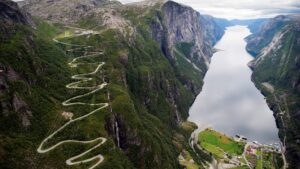
https://www.visitnorway.no/listings/p%C3%A5-hjul-rundt-lysefjorden-i-ryfylke/266830/
Day 7-8: Stavanger to Preikestolen and Kjerag – Hiking the famous mountains
Preikestolen, also known as Pulpit Rock, is a breathtaking cliff in Norway that rises 604 meters above the Lysefjorden, offering one of the most spectacular viewing points in the world. The plateau at the top measures about 25 meters on each side and provides stunning views over the fjord, making it a must-visit destination for nature lovers and hiking enthusiasts.
Drive: Stavanger to Preikestolen basecamp
Stay: Preikestolen BaseCamp for easy access to the hike.
Explore: Hike to Preikestolen and Kjeragbolten for thrilling views.
Eat: Pack a picnic to enjoy at the summit.
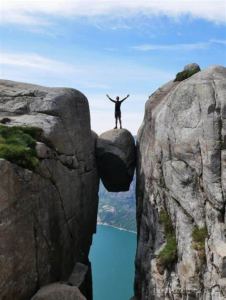
Getting There:
Preikestolen is accessible by bus and car from Stavanger, with buses departing daily to Preikestolen parking during the high season. For those driving, there’s a parking fee, and the car park also has charging points for electric cars. The area is also served by fjord cruises and ferries, providing a unique perspective of Preikestolen from the water.
Hiking to Preikestolen:
The hike is moderately challenging, covering a 3.8 km trail each way with a total elevation gain of 334 meters. It typically takes about two hours each way, starting from Preikestolenhytta. The trail is well-prepared, with parts of it made easier by bridges and Sherpa steps. Despite the trail’s steepness and the plateau’s open edges, the hike is considered safe, though visitors are reminded to act responsibly as there are no fences at the edge.
Accommodations and Facilities:
Near Preikestolen, you’ll find various accommodation options ranging from the historic Preikestolen Basecamp, which includes a mountain lodge, mini cabins, and camping sites, to other accommodations in the Ryfylke area. Preikestolen Basecamp also rents out clothing and equipment for the hike.
Best Time to Visit:
The peak season for hiking Preikestolen is from April to October. However, visiting during the off-season offers unique experiences, such as sunrise hikes in autumn and winter treks with guides, which are recommended due to rapidly changing weather conditions.
Nearby Attractions:
Beyond Preikestolen, Lysefjord area boasts numerous attractions, including the historic town of Jørpel, the picturesque Lysefjord itself, and the quaint village of Forsand. The region is part of the Sustainable Destination Program, emphasizing efforts to preserve its natural beauty while accommodating tourists. For those seeking a guided experience, hikes to Pulpit Rock with professional guides are available, providing insights into the area’s history, geology, and flora and fauna, ensuring a safe and enriching journey. For more and planning your hike to Preikestolen, visit official tourism such asord Norway and Visit Norway.
Day 9-10: Stavanger to Hardangerfjord – breathtaking landscapes with Waterfalls and Fruit Orchards
Hardangerfjord, often referred to as “the Queen of the Fjords,” presents a harmonious blend of awe-inspiring landscapes, rich heritage, and distinctive culinary experiences. This region is renowned for its remarkable natural beauty, including the iconic Trolltunga rock formation, majestic waterfalls such as Vøringsfossen, and the tranquil splendor of the fjord itself, establishing it as an essential destination in Norway.
Drive: Stavanger to Hardangerfjord (approx. 5 hours).
Explore: Visit Vøringsfossen waterfall, hike around the fruit orchards , take a fjord cruise.
Eat: Local cider tasting at a fruit farm.
Stay: Lofthus Camping in the heart of Hardanger. As a customer of Touring Campers, you get access to an exclusive discount code of 15%, which can be used on one booking in Campio.
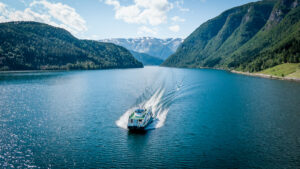
Key Attractions and Experiences:
Trolltunga: One of Norway’s most spectacular rock formations, offering stunning views over the Ringedalsvatnet lake.
Waterfalls: Hardanger is home to some of the most beautiful waterfalls, including Vøringsfossen, known for its impressive plunge into the Måbødalen valley.
Cider Tasting: The region is famous for its apple orchards, offering visitors the chance to taste local ciders and apple juices. Many farms also offer tastings of their cider products, which have gained popularity across Norway.
Hiking: There are numerous hiking trails, such as the HM Queen Sonja’s panoramic hike (Dronningstien), offering accessible yet stunning views compared to the more challenging Trolltunga hike.
Fjord Cruises: Exploring the fjord by boat offers a unique perspective of the area’s natural beauty. Various fjord cruises and tours are available, including a cider cruise that stops at local farms.
Accommodations and Travel Tips:
Hardanger offers a diverse range of accommodations, including historic hotels such as Utne Hotel, which has been operating since 1722, and modern establishments like the Hardangerfjord Hotel. For a truly unique experience, one might consider staying in a treehouse at Woodnest – Odda, which provides breathtaking views of the fjord.
Planning Your Visit:
The Norwegian Scenic Route Hardanger is a stunning drive that takes you close to fjords, mountains, waterfalls, and fruit farms. It is a 158 km route that includes several sections and requires crossings in parts. This scenic route offers an excellent opportunity to explore the region at your own pace, with numerous activities, attractions, and walking paths along the way. Hardangerfjord’s natural beauty and cultural experiences make it a compelling destination for travelers seeking to explore Norway’s spectacular fjords. Whether you are interested in adventure, relaxation, or culinary delights, Hardanger offers an unforgettable experience with its breathtaking landscapes, rich history, and welcoming. For more information on planning your trip, including activities, accommodations, and dining options, see Visit Norway – Hardangerfjord and visit the official tourism websites for Hardangerfjord.
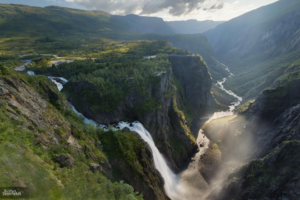
Day 11-12: Hardangerfjord to Bergen – Historical and Cultural Hub
Bergen, renowned as the Gateway to the Fjords, is situated between Norway’s two largest fjords, the Hardangerfjord the Sognefjorden This picturesque city, rich in history and culture, is also a UNESCO World Heritage site, celebrated its stunning fjords, historic, and vibrant cultural life.
Drive: Hardangerfjord to Bergen (approx. 2 hours).
Explore: Bryggen Hanseatic Wharf , Fløyen Mountain , Bergen Fish Market
Eat: Enhjørningen Fish Restaurant offers traditional Norwegian seafood.
Stay: Bergen Camping Park or Freecamp Park4night – Bergen and Bergenshallen parking for motorhomes and campervans.
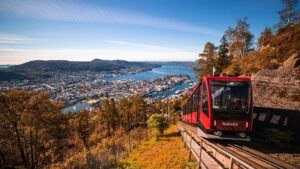
Key Attractions:
Bryggen: The iconic wharf of Brygen, a UNESCO World Heritage Site, reflects’s historical significance in European trade. Strolling through its narrow alleyways and exploring the Hanse Museum and Bryggens Museum provides an in-depth look into the medieval era of Bergen.
Fjord Tours: Bergen’s strategic location makes it an ideal starting point for fjord tours. The city provides access to breathtaking natural landscapes the Norwegian fj, which are recognized by UNESCO and have been voted the most unspoiled tourist destination by National Geographic.
Mount Fløyen: To enjoy breathtaking views of Bergen, the fjords, and surrounding mountains, a trip to Mount Fløyen via the Fløibanen is essential. The journey to the is an experience in itself, providing panoramic vistas and various outdoor activities.
Old Bergen Museum: This open-air museum provides a glimpse into what Bergen was like in the 19th century, showcasing 55 original wooden houses from the city center.
Cultural Highlights:
Bergen boasts a rich cultural scene, encompassing music, art galleries, and international festivals. It is home to the Bergen Philharmonic Orchestra, one of the world’s oldest symphony orchestras, the birthplace of renowned composers such as Edvard Gr. His residence, Troldhau, serves as a popular cultural attraction, providing insights into his life and work.
Gastronomy:
In recent years, Bergen has gained recognition as a UNESCO City of Gastronomy. The city’s culinary scene is diverse, ranging from traditional Norwegian seafood at the local Fish Market to international cuisines, reflecting its status as an international culinary city.
Practical Information:
Bergen Card: Offers free or discounted access to most museums and attractions, as well as public transportation within Bergen and the surrounding Vestland county. For more detailed information on planning your visit, including attractions, accommodations, and seasonal activities, the official tourism websites such as Visit Norway – Bergen and Visit Bergen offer comprehensive guides and inspiration for your trip.
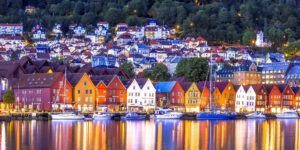
https://www.visitnorway.com/places-to-go/fjord-norway/bergen/behind-bryggen/
Day 13-14: Bergen to Ålesund
Ålesund, renowned for its distinctive Art Nouveau architecture serves a gateway to the breathtaking landscapes of Norway’s fjords, including Geirangerfjord and Hjørundfjord. This coastal city provides a rich combination of historical insights, outdoor adventures, and culinary delights.
Drive: Bergen to Ålesund (approx. 8 hours, including ferry).
Explore: Art Nouveau architecture tour, visit the Atlantic Sea Park
Eat: Maki Fish Café for fresh seafood, TripAdvisor – Maki Fish Cafe
Stay: Ålesund Camping or Volsdalen Camping
Things to Do:
Explore Local Cuisine: Ålesund is renowned for its seafood, particularly klfisk (dried and salted cod), local specialty used in the dish baco. The XL Diner is one of the city’s upscale venues known for its klippfisk dishes.
Hiking and Outdoor Activities: The nearby Giske archipelago provides numerous hiking opportunities, including a popular cultural trail on Valderøy Island and the challenging ascent Storhornet on Godøya Island.
Fjord Cruises: A fjord cruise in Hjørundfjord is a must-do, offering breathtaking views of the Sunnmøre Alps and the opportunity to explore historic hotels like Hotel Union Øye.
Sunnmøre Museum: An open-air museum showcasing a collection of traditional Norwegian buildings and boats, including replicas of Viking ships.
Runde Bird Island: Known for its significant seabird population, including puffins, Runde offers unique opportunities for bird watching and hiking.
Alnes Lighthouse on Godøy Island: This historic lighthouse and the picturesque fishing village of Alnes are worth a visit for their cultural and scenic value.
Getting There and Around:
Ålesund is accessible by air, with flights from major Norwegian cities. The city also welcomes many visitors via cruise ships. Once, the city’s compact size makes it to explore on foot, though local buses are available for attractions further afield. Ålesund serves as an excellent base for exploring the fjords, with boat tours available for exploration. For more detailed planning and insights into Ålesund’s attractions, accommodations, and travel tips, visit sources like Visit Norway – Ålesund and Sunnmøre, Heart My Backpack, and PlanetWare.
https://www.visitnorway.no/listings/fjelltur-til-storhornet-p%C3%A5-god%C3%B8y/199730/
Day 15-16: Ålesund to Geirangerfjord – The Jewel of the Norwegian Fjords
Geiranger, located in the heart of Norway, is renowned for its stunning Geangerfjord, a UNESCO World Heritage Site celebrated for exceptional beauty. destination is a must- for wishing to the quintessential Norwegian fjord landscape, characterized by steep mountains, deep waters, and cascading waterfalls such as the iconic Seven Sisters and The Suitor.
Drive: Ålesund to Geiranger (approx. 2.5 hours).
Explore: Dalsnibba Skywalk , Eagle Road, Geirangerfjord Cruise
Eat: Westeras Farm for local cuisine with a view, TripAdvisor – Westeras Farm Restaurant
Stay: Grande Hytteutleige og Camping
Key Attractions:
The Seven Sisters Waterfalls: These magnificent falls, named for their resemblance to long women’s hair, are a highlight of any visit to Geirangerfjord, offering a spectacular natural display.
Ørnevegen (The Eagle Road) and Flydalsjuvet: These viewpoints provide jaw-dropping vistas of the fjord and its surrounding landscapes, perfect for capturing memorable photos.
Geiranger Skywalk Dalsnibba: Standing at 1,500 meters above sea level, this platform offers unparalleled views of Geirangerfjord, making it a prime spot for sightseeing.
Activities:
Geiranger offers more than just sightseeing; it serves as a center for outdoor adventures. Visitors can admire the fjord’s beauty by embarking on a fjord cruise, hiking to waterfalls as Storsæterfossen, or experiencing the traditional fjord life by visiting mountain farms like Knivsflå For those a unique experience, a kayak or RIB boat trip provides an intimate encounter with the fjord’s serene waters and majestic waterfalls.
Getting There:
Geirangerfjord is accessible by boat enabling visitors to sail from Ålesund directly into the heart of the fj to the town of Geanger. This journey offers a front-row view of the fjord’s waterfalls and steep cliffs. those traveling by car, scenic routes along the fjord provide stunning landscapes, with ferry crossings adding to the adventure.
Best Time to Visit:
The optimal time to visit Geirangerfjord is from May to June, when the waterfalls are peak, or between July and for the warm weather and longest days. Although summer is peak season, providing the best conditions exploration and the most extensive range of services, Geiranger’s beauty is perennial.For more detailed information, planning tips, and to book tours, visit official tourism websites like Visit Norway – Geirangerfjorden and FjordNorway – Geirangerfjorden. These resources provide comprehensive guides to help you make the most of your visit to Geiranger and the surrounding fjord region.
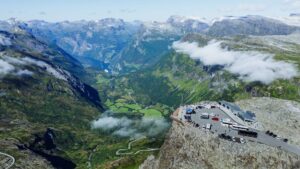
https://www.visitnorway.com/listings/geiranger-skywalk-dalsnibba/239273/
Day 17-18: Geiranger to Lom – Gateway to Jotunheimen
Lom, nestled at the heart of southern Norway’s majestic national parks, is a picturesque village offering an array of outdoor and cultural experiences. This National Park Village serves as a gateway to Jotunheimen, Breheimen, and Reinheimen National Parks, making it an ideal base for exploring some of Norway’s most stunning landscapes.
Drive: Geiranger to Lom (approx. 2.5 hours).
Explore: Lom Stave Church , Norwegian Mountain Center.
Eat: Bakeriet i Lom Bakeriet i Lom for traditional Norwegian pastries.
Stay: Lom Camping Lom Camping or freecamp Park4night – Lom
Key Attractions:
Lom Stave Church: One of Norway’s finest stave churches, dating back to 1158, this historic site is a must-visit for its unique architecture and rich history.
Norwegian Mountain Center: A comprehensive visitor center for the surrounding national parks, offering information on hikes, guided tours, and an interactive exhibition that brings the outdoors indoors.
National Parks: Lom is the perfect starting point for adventures into Jotunheimen National Park, home to Norway’s two highest mountains, Galdhøpiggen and Glittertind. The region offers countless hiking, skiing, and skimountaineering opportunities.
Activities and Experiences:
From thrilling hikes like the Besseggen ridge to exploring local food traditions, Lom and Jotunheimen are rich in activities. The area is known for its outdoor cafés, restaurants, shops, and well-developed construction practice, offering a glimpse into the Norwegian way of life in harmony with nature.
Accommodation and Dining:
Lom offers a variety of accommodation options, from mountain lodges and hotels to cabins and camping sites. The region’s culinary scene is rooted in long-standing traditions, using local produce to create delightful Norwegian dishes. For a truly unique stay, consider options like farm stays to immerse yourself in the local culture and landscape.
Planning Your Visit:
When planning a visit to Lom, it’s advisable to explore the wealth of information available at the tourist information center in Lom or through online resources. They provide valuable insights into activities, events, accommodation, shopping, and services in the area.
Lom’s strategic location makes it an excellent spot for those looking to explore the natural beauty of Norway’s national parks, engage in outdoor activities, and experience the rich cultural heritage of the region. Whether you’re an avid hiker, a history enthusiast, or simply looking to relax amidst stunning landscapes, Lom offers a memorable escape into the heart of Norway’s wilderness. For more detailed information, planning tips, and to book tours, visit official tourism websites like Visit Norway – Lom, Jotunheimen.
https://www.visitnorway.it/listings/lom-stave-church-among-the-largest-and-oldest/182786/
Day 19-20: Lom to Rondane National Park – Untouched Wilderness
Rondane National Park, in 1962 as Norway’s first national park, is a sanctuary for outdoor enthusiasts and nature lovers. This magnificent landscape features towering mountain peaks, expansive plateaus blanketed in heather andichen, and deep valleys providing a tranquil into nature.
Drive: Lom to Rondane (approx. 2 hours).
Explore: Hiking in Rondane National Park , visit Sohlbergplassen viewpoint.
Eat: Rondane Gjestegård for local game dishes.
Stay: Rondane River Camp or freecamp Park4night – Rondane
Activities and Attractions:
Hiking: Rondane boasts a multitude of hiking trails, from gentle walks to demanding treks, all ages and fitness levels. The park features ten peaks exceeding 2,000, with Rondslottet being the highest at ,178 meters, offering hikers stunning vistas of the surrounding Norwegian mountains.
Wildlife Viewing: The park serves as a vital for wild reindeer, providing unique opportunities to observe these magnificent creatures in their natural environment.
Cycling and Skiing: For cycling enthusiasts, the Rondane Tour is a popular route that the park’s dramatic landscapes. In winter, park transforms into a snowy wonderland, perfect cross skiing.
Accommodation:
Rondane and its surrounding areas provide a range of accommodations, cozy mountain lodges, cabins, and hotels, to suit various and budgets. For a truly immersive experience, staying in one of mountain lodges, which serve as ideal bases for exploring the vast wilderness.
Best Time to Visit:
Rond National Park is accessible and throughout the year, with each season providing a distinct experience. Summer and autumn are perfect for and admiring the vibrant colors of the scenery, while winter offers a magical snowy landscape ideal for skiing and snowshoeing.
Getting There:
Located in Eastern Norway, near the Gudbrandsdalen valley, Rondane is accessible by car, bus, or train. The closest major towns are Otta and Dombås, which provide excellent public transport connections to the park. For those traveling by car, the Norwegian Scenic Route Rondane offers a stunning drive with ample opportunities to stop and admire the scenery. For more detailed information on planning your trip to Rondane National Park, including activities, accommodation options, and travel tips, visit Visit Norway – Rondane Moutains and Visit Norway – Rondanavegen websites.
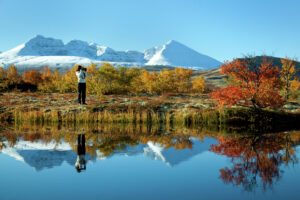 https://www.visitnorway.no/reisemal/ostlandet/rondane/
https://www.visitnorway.no/reisemal/ostlandet/rondane/
Day 21-22: Rondane to Oslo – Completing your roadtrip
Drive: Rondane to Oslo (approx. 5 hours).
Explore: Last-minute shopping in Grünerløkka , relax at Sørenga Seawater Pool.
Eat: Dinner at Maaemo for a special end-of-trip celebration (reservation needed).
Stay: Ekeberg Camping Ekeberg Camping for the final night.
Return: Return your campervan from Touring Campers at Oslo Gardermoen Airport.
Ready to explore? Rent a campervan here at Touring Campers!


